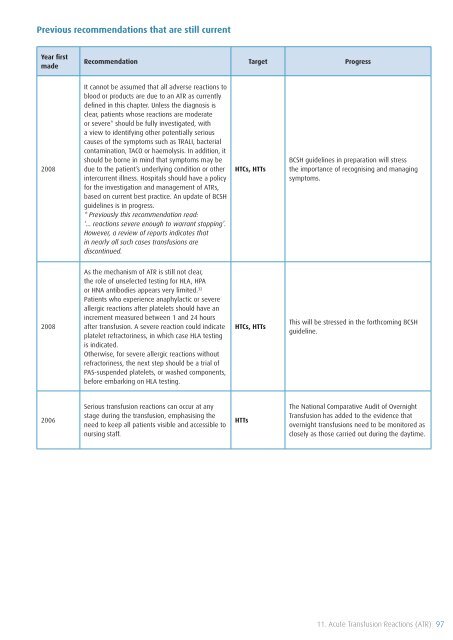SHOT Annual Report 2009 - Serious Hazards of Transfusion
SHOT Annual Report 2009 - Serious Hazards of Transfusion
SHOT Annual Report 2009 - Serious Hazards of Transfusion
You also want an ePaper? Increase the reach of your titles
YUMPU automatically turns print PDFs into web optimized ePapers that Google loves.
Previous recommendations that are still current<br />
Year first<br />
made<br />
Recommendation Target Progress<br />
2008<br />
It cannot be assumed that all adverse reactions to<br />
blood or products are due to an ATR as currently<br />
defined in this chapter. Unless the diagnosis is<br />
clear, patients whose reactions are moderate<br />
or severe* should be fully investigated, with<br />
a view to identifying other potentially serious<br />
causes <strong>of</strong> the symptoms such as TRALI, bacterial<br />
contamination, TACO or haemolysis. In addition, it<br />
should be borne in mind that symptoms may be<br />
due to the patient’s underlying condition or other<br />
intercurrent illness. Hospitals should have a policy<br />
for the investigation and management <strong>of</strong> ATRs,<br />
based on current best practice. An update <strong>of</strong> BCSH<br />
guidelines is in progress.<br />
* Previously this recommendation read:<br />
‘… reactions severe enough to warrant stopping’.<br />
However, a review <strong>of</strong> reports indicates that<br />
in nearly all such cases transfusions are<br />
discontinued.<br />
HTCs, HTTs<br />
BCSH guidelines in preparation will stress<br />
the importance <strong>of</strong> recognising and managing<br />
symptoms.<br />
2008<br />
As the mechanism <strong>of</strong> ATR is still not clear,<br />
the role <strong>of</strong> unselected testing for HLA, HPA<br />
or HNA antibodies appears very limited. 32<br />
Patients who experience anaphylactic or severe<br />
allergic reactions after platelets should have an<br />
increment measured between 1 and 24 hours<br />
after transfusion. A severe reaction could indicate<br />
platelet refractoriness, in which case HLA testing<br />
is indicated.<br />
Otherwise, for severe allergic reactions without<br />
refractoriness, the next step should be a trial <strong>of</strong><br />
PAS-suspended platelets, or washed components,<br />
before embarking on HLA testing.<br />
HTCs, HTTs<br />
This will be stressed in the forthcoming BCSH<br />
guideline.<br />
2006<br />
<strong>Serious</strong> transfusion reactions can occur at any<br />
stage during the transfusion, emphasising the<br />
need to keep all patients visible and accessible to<br />
nursing staff.<br />
HTTs<br />
The National Comparative Audit <strong>of</strong> Overnight<br />
<strong>Transfusion</strong> has added to the evidence that<br />
overnight transfusions need to be monitored as<br />
closely as those carried out during the daytime.<br />
11. Acute <strong>Transfusion</strong> Reactions (ATR) 97












